





Looking into peat moss alternatives makes sense, from both financial and environmental viewpoints. Coconut coir and rice hulls are two currently popular candidates for "greener" choices. This spring, I'm trying both as additions to my regular potting mix.
PEAT MOSS
Peat moss makes up the bulk of most potting mixes and is great for working into garden beds. I've used it for years. The cost of peat moss is increasing, however, and I've also wondered about the potential environmental impact of peat mining. Peat moss arrives at the store in dried, compressed bales, but it comes from peat bogs, in Canada, Europe, and New Zealand.
Public concern over these bogs has resulted in improved wetland conservation and management policies, according to the CSPMA.[1] Like timber resources, peat bogs can be managed to reduce the impact of harvesting. Some argue, however, that a managed or restored peat bog may be different from the original[2], in the same way that a pine tree plantation is different from old growth forest.
What if we could reduce our reliance on peat moss? Better yet, what if we could replace it with the "useless" byproducts of other harvested crops? Coconut coir is made from ground coconut husks, and rice hulls are left over when rice is harvested and processed for sale. Both of these products have been getting a lot of attention lately, and I wanted to give them a try.
COIR
The fibrous outer husks of coconuts are used to create ropes, mats, and other rough textiles. If you break apart a coconut husk, you can clearly see the strands of fiber. 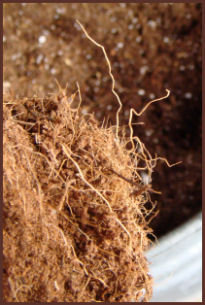 You'll also see the matrix that holds them together, which is left over when the useful fiber has been processed. This coconut husk "dust" is marketed as coir (pronounced KOI-er). If you think of the coconut meat as the main crop of the coconut palm, then coir is a left-over leftover.
You'll also see the matrix that holds them together, which is left over when the useful fiber has been processed. This coconut husk "dust" is marketed as coir (pronounced KOI-er). If you think of the coconut meat as the main crop of the coconut palm, then coir is a left-over leftover.
Coconut coir generally comes in compressed blocks or bricks. Much smaller than peat moss bales, they will expand more than you'd believe when moistened. My block of coir measured about a third of a cubic foot. 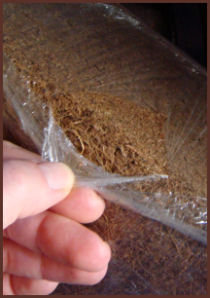 Several gallons of water later, it had expanded to fill a 22-gallon storage tub. Working with coir takes very little effort. Just drop the brick into an appropriate container (a trash can works well), add water, and return in a few hours. It absorbs water readily and takes less fluffing and crumbling than either the compressed peat moss or bales of Pro Mix I've been using.
Several gallons of water later, it had expanded to fill a 22-gallon storage tub. Working with coir takes very little effort. Just drop the brick into an appropriate container (a trash can works well), add water, and return in a few hours. It absorbs water readily and takes less fluffing and crumbling than either the compressed peat moss or bales of Pro Mix I've been using.
Not all coir is created equal. If you picture coconut palms swaying along a tropical beach, you won't be surprised to hear that some coconut coir is salty. If you purchase salty coir, it will work just fine, but you'll need to rinse it with a couple of changes of water before use. Even then, testing the coir mix with one plant is probably a good idea before you repot your entire collection of prized begonias. I opted for the easy route and got my coir from a local market grower who assured me there was no need to rinse it.
If you grow in straight coir, as some folks do, bear in mind that coir doesn't have much in the way of nutrients to give to your plants. You'll need to add some slow release fertilizer, or water with a fertilizer solution. A handful of compost may also be a good idea. Consider the needs of whatever you are planting. Most herbs are fine in a lean mixture, but other plants like roses and tomatoes tend to be heavy feeders.
 RICE HULLS
RICE HULLS
After rice is harvested, the grains are dried and hulled before being polished, parboiled or "converted," or sold as brown rice. Rice hulls are thin, feather-light with the thin, pointed shape of rice grains. They can be used on their own, to lighten soil and improve both drainage and water retention. Or they can be added to potting mixes for seedlings and containers. 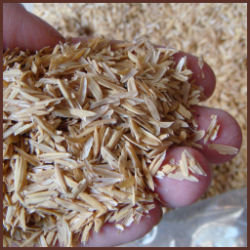 I think of the hulls as being similar to vermiculite, another other product I've used for years.
I think of the hulls as being similar to vermiculite, another other product I've used for years.
You may be able to find rice hulls at your local nursery. For a probably cheaper source, check the yellow pages for a brewing supply company. Home-brewers use rice hulls for filtering beer after fermentation. Mid-Altlantic DGer SallyG found a local source for us to try at about a dollar a pound (Thanks, Sally!).
Wanting to be cautious about using a new-to-me product, I added two and a half pounds of rice hulls (about 2 gallons) to 20 gallons of un-compressed coir. They do seem to swell up a lot when wet, so I didn't want to overdo it.
RESULTS
I took a conservative approach this year. 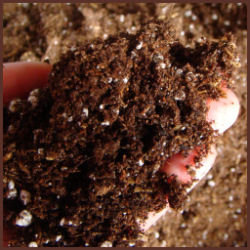 My seedlings were all transplanted into a half and half mixture of my usual peat-based potting mix plus coconut coir lightened with a generous addition of rice hulls. I also added my usual helping of polymer moisture crystals.
My seedlings were all transplanted into a half and half mixture of my usual peat-based potting mix plus coconut coir lightened with a generous addition of rice hulls. I also added my usual helping of polymer moisture crystals. 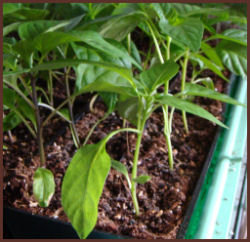 The resulting mix is similar to what I've used before, and my seedlings are growing enthusiastically in it. Between the rice hulls and the polymer crystals in my mix, I'm only watering my seedlings every three or four days. So far, it's been a great success!
The resulting mix is similar to what I've used before, and my seedlings are growing enthusiastically in it. Between the rice hulls and the polymer crystals in my mix, I'm only watering my seedlings every three or four days. So far, it's been a great success!
Although it might have been a greener choice to get away from it entirely, for now I'm satisfied with reducing my use of peat moss by adding coconut coir and rice hulls to my commercial potting mix. I hope you'll try some of these "recycled" products in your own gardens and containers this year.
Move your mouse over image and links in this article for more information (let the cursor hover for a few seconds, and a caption will pop up).
Photos by Jill M Nicolaus.
[1] See this issues paper from the Canadian Sphagnum Peat Moss Association website.
[2] See this overview of peat moss issues in Natural Life Magazine.
Copyright © www.100flowers.win Botanic Garden All Rights Reserved